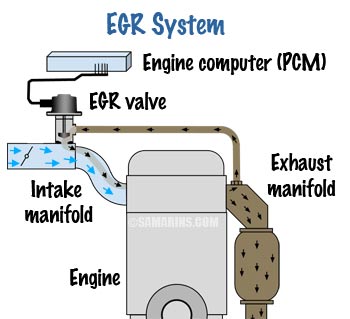Exhaust Gas Recirculation or EGR system:
The Exhaust Gas Recirculation or EGR system is one of several vehicle emission control systems. It helps reduce the amount of the nitrogen oxides (NOx) in the exhaust gases. Nitrogen oxides are normally formed in the process of combustion in the engine cylinders.
 EGR system. Click for a larger image. |
However, their formation increases dramatically at higher combustion temperatures (above 1600 °C or 2912 °F).
The EGR system reduces the combustion temperature by diverting a small portion of the exhaust gases back into the intake manifold.
How does it work?
Exhaust gases are no longer combustible. Diluting the intake air with exhaust gases makes the air/fuel charge less combustible.
Not all vehicles are equipped with an EGR system; many newer cars utilize a variable valve timing and other means to control the combustion temperatures and NOx emissions.
The majority of modern diesel vehicles incorporate EGR valves into their design to reduce NOx emissions and therefore meet stringent emissions regulations. EGR systems recycle a portion of the exhaust gas back into the combustion chamber, where it combines with fresh intake air.
This lowers the Oxygen content and increases the water vapour content to the combustion mixture which reduces peak combustion temperature. Because more NOx is created as peak combustion temperature rises, the EGR valve effectively reduces the amount of NOx produced by the engine.
The EGR valve begins working once the engine is started, attains the correct operating temperature and speed increases. Gradually, the EGR valve regulates the flow of exhaust gases. Once you slow down and the engine stops, the EGR valve will return to its closed position and prevent the flow of exhaust gases.
Advantages of EGR
- Reduced NOx
- Potential reduction of throttling losses on spark ignition engines at part load
- Improved engine life through reduced cylinder temperatures (particularly exhaust valve life)
Disadvantages
Since EGR reduces the available oxygen in the cylinder, the production of particulates (fuel which has only partially combusted) is increased when EGR is applied. This has traditionally been problem with diesel engines, where the trade-off between NOx and particulates is a familiar one to calibrators.
The deliberate reduction of the oxygen available in the cylinder will reduce the peak power available from the engine. For this reason the EGR is usually shut off when full power is demanded, so the EGR approach to controlling NOx fails in this situation.
The EGR valve can not respond instantly to changes in demand, and the exhaust gas takes time to flow around the EGR circuit. This makes the calibration of transient EGR behavior particularly complex- traditionally the EGR valve has been closed during transients and then re-opened once steady state is achieved. However, the spike in NOx / particulate associated with poor EGR control makes transient EGR behavior of interest.
The recirculated gas is normally introduced into the intake system before the intakes divide in a multi-cylinder engine. Despite this, perfect mixing of the gas is impossible to achieve at all engine speeds / loads and particularly during transient operation. For example poor EGR distribution cylinder-to-cylinder may result in one cylinder receiving too much EGR, causing high particulate emissions, while another cylinder receives too little, resulting in high NOx emissions from that cylinder.

Comments